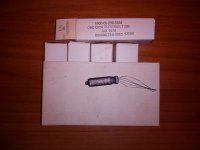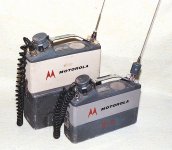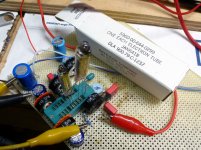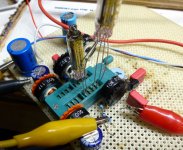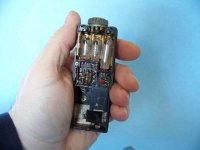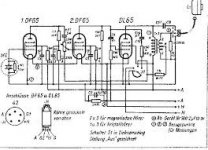hi all, have 5 of these little 5678s, any ideas for a project?
Originally used in push to talk sets (walkie talkies)
Not intended for audio and quite useless as the filaments on these wear out pretty quick
316a
I've used some similarly short lived filamentary triodes in audio projects. These pentodes seem to have rather good characteristics when triode connected. Perhaps suitable for some project where they will receive sporadic use or where they can be easily replaced. Maybe a simple battery operated line stage or similar.
http://www.mif.pg.gda.pl/homepages/frank/sheets/138/5/5678.pdf
http://www.mif.pg.gda.pl/homepages/frank/sheets/138/5/5678.pdf
1) 100 mA slow blow fuse
2) hearing aid amplifier with crystal earpiece
Get some 5902 or 5639 sub-mini tubes if you want to actually hear anything in a room. (small speaker amp, headphone amp)
http://tubedata.milbert.com/sheets/141/5/5902.pdf
http://tubedata.milbert.com/sheets/137/5/5639.pdf
2) hearing aid amplifier with crystal earpiece
Get some 5902 or 5639 sub-mini tubes if you want to actually hear anything in a room. (small speaker amp, headphone amp)
http://tubedata.milbert.com/sheets/141/5/5902.pdf
http://tubedata.milbert.com/sheets/137/5/5639.pdf
Last edited:
I just want to build something with them for the fun of it, and maybe learn something along the way.
The ironic comments are not needed, i have never treated anyone here like this.
The ironic comments are not needed, i have never treated anyone here like this.
the filaments on these wear out pretty quick
There are several filamentary tubes designed for military radio use, and the 5678 is one of them. The filament current varies from 10 mA on the 6418, 20 mA on the 6088, to 50 ma on the 5678.
The 5678 was used in several Motorola "Pack Set" radios that pre-date walkie talkies. These are from the early 1960s. The radios were intended for rather rough service and the tubes inside were not known for short life.
I have found that the 6418 with it's thinner than a hair filament is horrendously microphonic and tend to be short lived, especially when subject to vibration. The 6088 is better, and the 5678 is better still.
These tubes would be used whenever you need both small size and low power operation. There are plenty of other tubes that would be better choices if both power and size were not the main constraints.......So what am I doing with mine?
guitar amp.... You must be joking
Well, not a complete amp yet, but I wanted a high impedance preamp for a piezo pickup in the string saddle (Ghost Pickups). There are 6 strings, so this means 6 piezo elements, with 6 pickups. I have one preamp working on a crude breadboard test circuit. Shown here with a 6418 in it. I have tried all 3 tube types.
If a smallish battery powered guitar amp is something you are interested in you could use 3 of these tubes, 2 for the preamp, and one for the PI, then use a pair of 7 pin tubes like the 3A4 for a watt or so, or the 6AK5 for a bit more.
I'm thinking that the preamp should be made with these tiny tubes and the power amp will be a Class D amp. All of this is intended to be stuffed inside the body of an electric guitar.
Another experiment that is not quite working yet, OK it doesn't work at all, is a Moog style ladder filter made with a mix of tubes and transistors. It may eventually find its way into a Eurorack module, so small size and low power are big reasons for not using a hand full of 12AX7's.
Attachments
A headphone O/P AM receiver is an excellent project for the 5678. You don't need a 1N34.
A somewhat used alkaline cell will make a suitable filament supply. Stack 006P 9 V. batteries to obtain the B+. Switching only the filament supply works, as no B+ draw occurs, with the filament cold.
You will need a long wire antenna and a good earth ground. Use a grid leak detector along these lines. The "classic" RC network at g1 is a 250 pF. mica cap. and a 2.2 Mohm carbon comp. resistor.
The antenna coil and tuning cap. can sourced from AES.
A somewhat used alkaline cell will make a suitable filament supply. Stack 006P 9 V. batteries to obtain the B+. Switching only the filament supply works, as no B+ draw occurs, with the filament cold.
You will need a long wire antenna and a good earth ground. Use a grid leak detector along these lines. The "classic" RC network at g1 is a 250 pF. mica cap. and a 2.2 Mohm carbon comp. resistor.
The antenna coil and tuning cap. can sourced from AES.
Nice little tube. Are these still in production? I suppose not. I've never seen them in any of the online stores where I usually buy tubes/parts.
Are these still in production? I suppose not.
Plenty of them to be found on Ebay. I got a box of these:
100 PIECES NOS NIB RAYTHEON JAN 5678 CV2254 AUDIO AMPLIFIER TUBES VALVES PERFECT | eBay
A headphone O/P AM receiver is an excellent project for the 5678.
The radios built in the 20's and 30's used rather high impedance (5K to 10K ohms) headphones which are rather rare today. Today's headphones are 600 ohms or less. That circuit could be built as is if you added a small output transformer from an old tube radio between the tube and the headphones.
A somewhat used alkaline cell will make a suitable filament supply.
A rechargeable NiCad or NiMh cell would be a better choice. Both of these have a 1.2 to 1.25 volt nominal rating and can be recharged. A typical 1200 MaH cell would last for 24 hours of continuous operation before needing a recharge. An alkaline cell can be over 1.5 volts when new. These little filaments don't like excess voltage. Having said that, I have tested one of these tubes to 1.75 volts without blowing it, but who knows what that did to its life expectancy.
The radios built in the 20's and 30's used rather high impedance (5K to 10K ohms) headphones which are rather rare today. Today's headphones are 600 ohms or less. That circuit could be built as is if you added a small output transformer from an old tube radio between the tube and the headphones.
An alternative to an O/P trafo is a load resistor in parallel with a readily available piezoelectric earplug. Of course, this somewhat costly item is perfect.
"readily available piezoelectric earplug.....is perfect"
http://tubedata.milbert.com/sheets/030/d/DF65.pdf
http://tubedata.milbert.com/sheets/030/d/DL65.pdf
DF tubes eh...🙄
http://tubedata.milbert.com/sheets/030/d/DF65.pdf
http://tubedata.milbert.com/sheets/030/d/DL65.pdf
DF tubes eh...🙄
Attachments
These 6J5B-V miniature tubes are long life type and really cheap. The life span is specified to be 3000h while normal 6J5B has only 500h.
I have built some pre amplifiers with these and work well.
10x 6J5B-V military pentode tubes, 10 pcs., new | eBay
I have built some pre amplifiers with these and work well.
10x 6J5B-V military pentode tubes, 10 pcs., new | eBay
6J5b-v datsheet:
https://artis3dots.files.wordpress....b-6j5b-6zh5b-6zh5b-v-6d0b65d0b1-datasheet.pdf
Rather rounded pentode knees, might be good for triodes. Mu ? (guessing around 20)
https://artis3dots.files.wordpress....b-6j5b-6zh5b-6zh5b-v-6d0b65d0b1-datasheet.pdf
Rather rounded pentode knees, might be good for triodes. Mu ? (guessing around 20)
Last edited:
- Status
- Not open for further replies.
- Home
- Amplifiers
- Tubes / Valves
- 5678 miniature tube project recommendation
